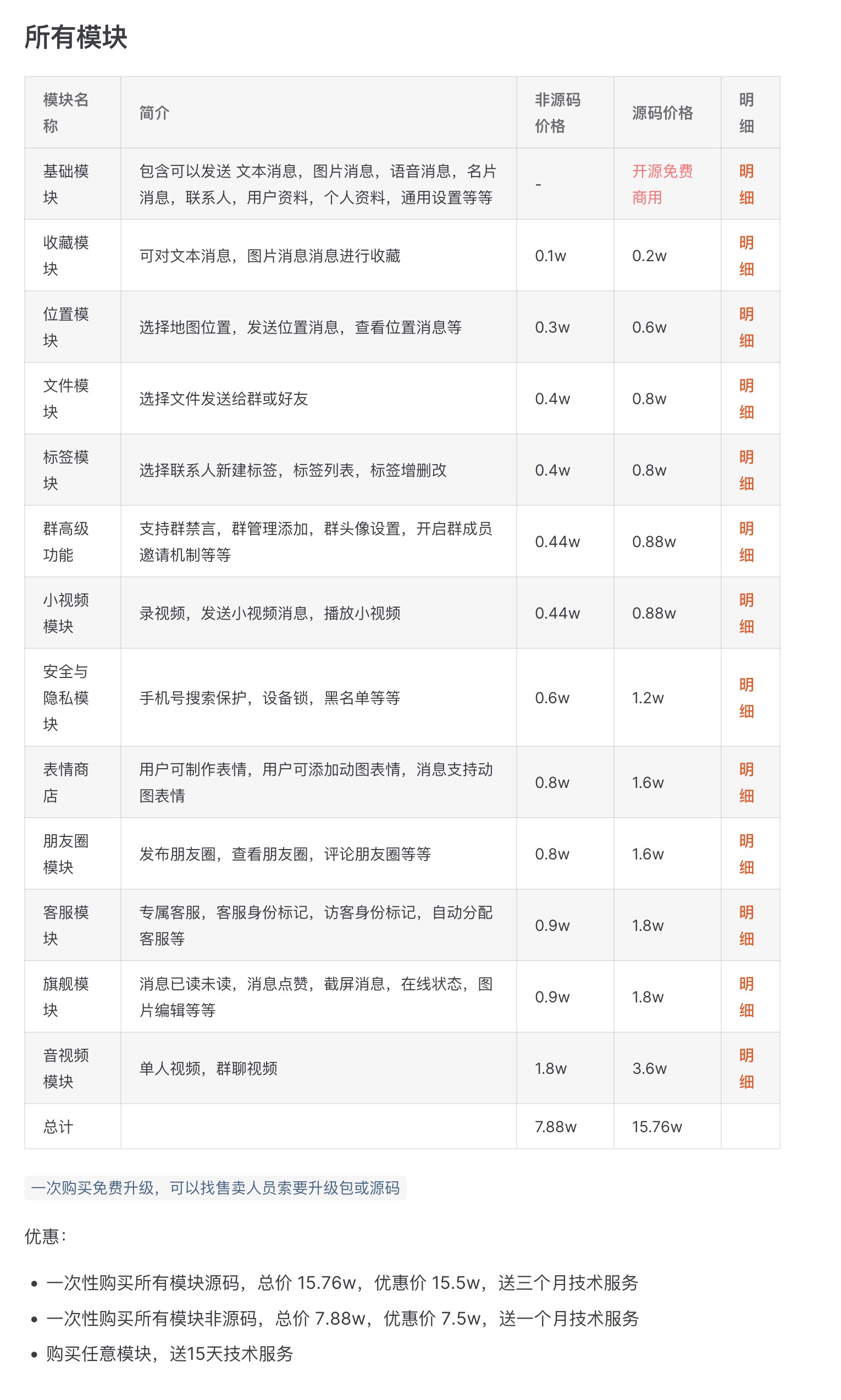TangSengDaoDao, An Open-Source Instant Messaging Software
Introduction:
TangSengDaoDao is a lightweight, high-performance, security-focused open-source instant messaging system, dedicated to private deployment.
Features:
- 🆓 Open Source & Free: Server-side code, APP code, Web/PC-side code are all open source under the Apache 2.0 open-source license (commercially usable), no one can control you.
- 🔏 Private Deployment: All programs and data are on your own server. No need to worry about data leakage or data being used for other purposes.
- 🆚 Guaranteed Message Delivery: Uses tcp + ack mechanism to ensure message delivery, supports offline messages, and message roaming.
- 🔐 Content Security: Message transmission uses a private binary encryption protocol, DH + streaming encryption, to prevent message content leakage.
- 💽 Permanent Message Storage: Messages support permanent storage, thanks to WuKongIM's proprietary messaging db. Permanent storage doesn't affect performance, just consumes some disk space.
- 📱 Multi-Device Message Sync: Supports 1 mobile end, multiple Web/PC ends online simultaneously, and real-time message synchronization between multiple devices.
- 📟 Full Platform Support: iOS, Android, Windows, MAC, Ubuntu, Web
Note:
In the self-deployed client, new users must use the iOS/Android app for registration and password recovery is not available.
The open source version has a lot of features that are not available and Tailchat is more recommended
Deployment Tutorial:https://enblog.fuyiran.link/Technology/13.html
System Requirements:
Configuration >= 2H8G
Deployment Steps:
Step 1: Update Source
Ubuntu/Debian:
apt update -y && apt upgrade -yCentos:
yum update -y && yum upgrade -yStep 2: Install and Set Up Docker
Install Docker:
curl -fsSL https://get.docker.com -o get-docker.sh && sudo sh ./get-docker.shStart Docker:
sudo systemctl start dockerSet Docker to auto-start on boot:
sudo systemctl enable dockerStep 3: Create Installation Directory
sudo mkdir -p ~/tsdd && cd ~/tsddStep 4: Configure Parameters
Configure
docker-compose.yamlfilenano docker-compose.yamlEnter the content below:
version: '3.1'
services:
wukongim: # TangSengDaoDao Communication Service (Wukong IM)
image: registry.cn-shanghai.aliyuncs.com/wukongim/wukongim:latest
restart: always
ports:
# - "5001:5001" # http api port (business side call, intranet open only)
- "5100:5100" # tcp long connection port (open for extranet)
- "5200:5200" # websocket port (open on extranet)
- "5300:5300" # monitor port
volumes:
- ./wukongim:/root/wukongim
environment:
- WK_MODE=${WK_MODE}
- WK_EXTERNAL_IP=${EXTERNAL_IP}
- WK_CONVERSATION_ON=true
- WK_WEBHOOK_GRPCADDR=tangsengdaodaoserver:6979
- WK_DATASOURCE_ADDR=http://tangsengdaodaoserver:8090/v1/datasource
- WK_DATASOURCE_CHANNELINFOON=true
- WK_TOKENAUTHON=true
tangsengdaodaoserver: # TangSengDaoDao's operational services
image: registry.cn-shanghai.aliyuncs.com/wukongim/tangsengdaodaoserver:latest
restart: always
command: "api"
healthcheck:
test: "wget -q -Y off -O /dev/null http://localhost:8090/v1/ping > /dev/null 2>&1"
interval: 10s
timeout: 10s
retries: 3
depends_on:
- redis
- mysql
- wukongim
ports:
- "8090:8090"
volumes:
- ./tsdd:/home/tsdddata
# - ./tsdd/configs/tsdd.yaml:/home/configs/tsdd.yaml
environment:
- TS_MODE=${TS_MODE}
- TS_WUKONGIM_APIURL=http://wukongim:5001
- TS_DB_MYSQLADDR=root:${MYSQL_ROOT_PASSWORD}@tcp(mysql)/${MYSQL_DATABASE}?charset=utf8mb4&parseTime=true&loc=Local
- TS_DB_REDISADDR=redis:6379
- TS_EXTERNAL_IP=${EXTERNAL_IP}
- TS_SMSCODE=${TS_SMSCODE}
- TS_FILESERVICE=${TS_FILESERVICE}
- TS_MINIO_ACCESSKEYID=${MINIO_ROOT_USER}
- TS_MINIO_SECRETACCESSKEY=${MINIO_ROOT_PASSWORD}
- TS_AVATAR_DEFAULTBASEURL=https://api.multiavatar.com/{avatar}.png
tangsengdaodaoweb: # TangSengDaoDao's web service
image: registry.cn-shanghai.aliyuncs.com/wukongim/tangsengdaodaoweb:latest
restart: always
environment:
- API_URL=http://${EXTERNAL_IP}:8090/
ports:
- "82:80"
tangsengdaodaomanager: # TangSengDaoDao's background management system
image: registry.cn-shanghai.aliyuncs.com/wukongim/tangsengdaodaomanager:latest
restart: always
environment:
- API_URL=http://${EXTERNAL_IP}:8090/
ports:
- "83:80"
minio: # minio document management service
image: minio/minio:latest # use a remote image
expose:
- "9000"
- "9001"
command: "server /data --console-address ':9001'"
ports:
- "9000:9000"
- "9001:9001"
environment:
- MINIO_ROOT_USER=${MINIO_ROOT_USER}
- MINIO_ROOT_PASSWORD=${MINIO_ROOT_PASSWORD}
healthcheck:
test: ["CMD", "curl", "-f", "http://localhost:9000/minio/health/live"]
interval: 30s
timeout: 20s
retries: 3
volumes:
- ./miniodata:/data
mysql: # mysql database
image: mysql:latest
command: --default-authentication-plugin=mysql_native_password
healthcheck:
test: ["CMD", "mysqladmin" ,"ping", "-h", "localhost"]
environment:
- TZ=Asia/Shanghai
- MYSQL_ROOT_PASSWORD=${MYSQL_ROOT_PASSWORD}
- MYSQL_DATABASE=${MYSQL_DATABASE}
volumes:
- ./mysqldata:/var/lib/mysql
redis: # redis
image: redis
restart: always
healthcheck:
test: ["CMD", "redis-cli", "ping"]
interval: 1s
timeout: 3s
retries: 30
adminer: # mysql web admin tool for debugging, don't open it for security purposes.
image: adminer:latest
ports:
- 8306:8080Configure
.envfilenano .envEnter the content below:
# Common config
# The IP address of the server.
EXTERNAL_IP=
# MYSQL Config
# The password of the root user of the mysql database
MYSQL_ROOT_PASSWORD=
# The name of the mysql database
MYSQL_DATABASE=im
# Minio Config
# The access key ID of the minio file service
MINIO_ROOT_USER=minio
# The secret access key of the minio file service
MINIO_ROOT_PASSWORD=
# WuKongIM Config
# debug or release
WK_MODE=debug
# TangSengDaoDao Config
# File service type, default is minio
TS_FILESERVICE=minio
# debug or release
TS_MODE=debug
# The SMS code for testing, if it is not empty, the SMS code will be this value (If you need to configure real SMS, please refer to the SMS configuration in the complete configuration)
TS_SMSCODE=123456You need to modify the following parameters:
- EXTERNAL_IP: External IP address of the server
- MYSQL_ROOT_PASSWORD: Password for the root user of the MySQL database, fill in randomly
- MINIO_ROOT_PASSWORD: Password for the Minio file service, fill in randomly (at least 8 characters)
- TS_SMSCODE: Default SMS verification code for mobile registration
Step 5: Start Docker Containers
docker compose up -dAnd open the following ports:
| Port | Description |
|---|---|
| 8090 | API port |
| 82 | Web IM port |
| 5100 | TCP long connection port |
| 5200 | Websocket port |
| 9000 | Minio file service port |
| 9001 | Minio file management port (optional) |
| 8306 | MySQL web management port (optional) |
After deployment, you can visit https://<your-ip>:82 to access TangSengDaoDao.
Step 6: Register New User
Log in on the mobile side, click on the settings in the top right corner.

In the server configuration, the server address is the server IP address, and the port is 8090. After configuring, click the Submit button.

Return to the login screen, long press the Welcome to TangSengDaoDao button to enter the hidden login screen.

On this page, input the TS_SMSCODE set earlier as the SMS verification code to register without actual verification.

After successful registration, you can log in on the Web end using your account password or mobile number.
Relevant Links:
Official Website: https://tangsengdaodao.com
GitHub: https://github.com/TangSengDaoDao/TangSengDaoDaoServer
Original link:http://enblog.fuyiran.link/Technology/44.html
Copyright: All posts on this blog, unless otherwise stated, are published using theCC BY-NC-SA 4.0 license agreement. Please indicate the source for reprinting Fu Speaking (enblog.fuyiran.link)